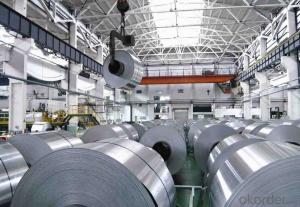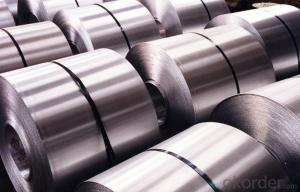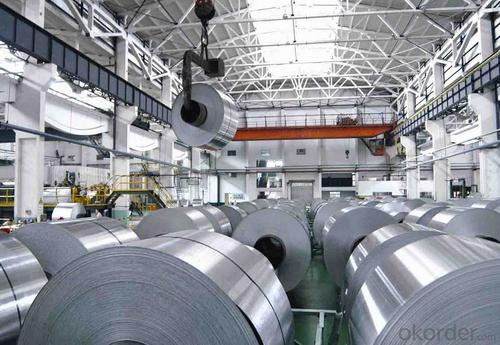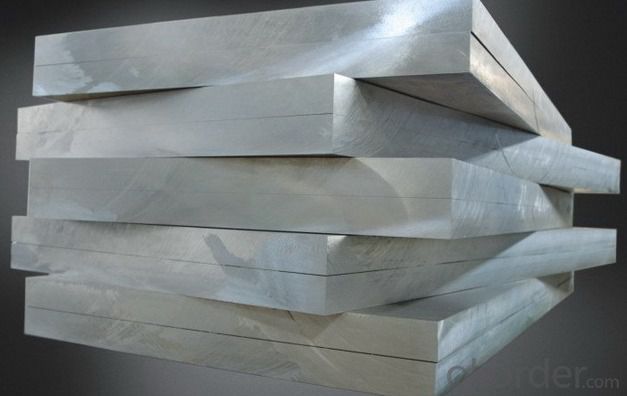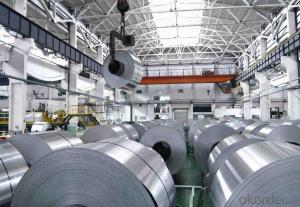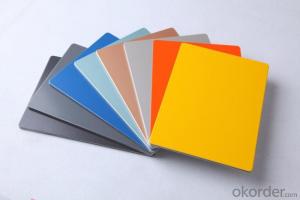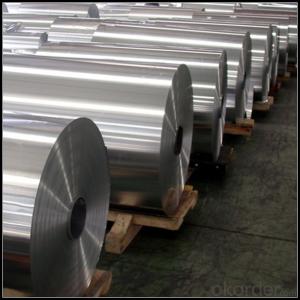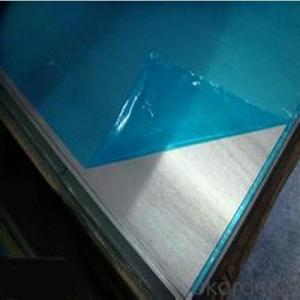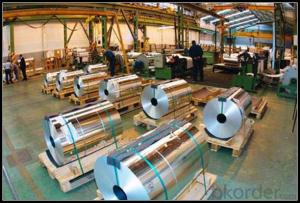CC Route Aluminum Sheet For Building Industries
- Loading Port:
- Shanghai
- Payment Terms:
- TT OR LC
- Min Order Qty:
- 1 m.t.
- Supply Capability:
- 2000 m.t./month
OKorder Service Pledge
OKorder Financial Service
You Might Also Like
Specification
Structure of Prepainted Aluminium Coil PPGL Description:
1) Alloy : 1A99,2A12,2024,2219,2618,2A50,2A70,5A06,5083,6082,7075,7050, 7A85,7020 etc
2) Temper: O/H12/H14/H1/H18/H32/H34/H36/H38//H111/H112/H116/H321/T6/T651/T3/T351 etc
3) Thickness: 0.1mm to 350mm
4) Width:20mm to 3300mm
5)Length: Accord to customer's requirements.
Main Features of Aluminium Coil PPGL:
1) Alloy : 1A99,2A12,2024,2219,2618,2A50,2A70,5A06,5083,6082,7075,7050, 7A85,7020 etc
2) Temper: O/H12/H14/H1/H18/H32/H34/H36/H38//H111/H112/H116/H321/T6/T651/T3/T351 etc
3) Thickness: 0.1mm to 350mm
4) Width:20mm to 3300mm
5)Length: Accord to customer's requirements.
Images of Aluminium Coil PPGL:
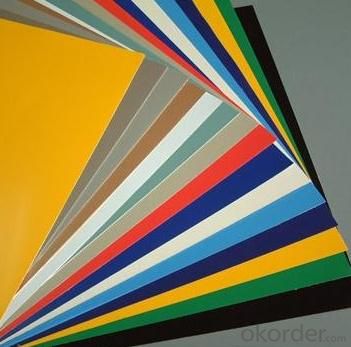
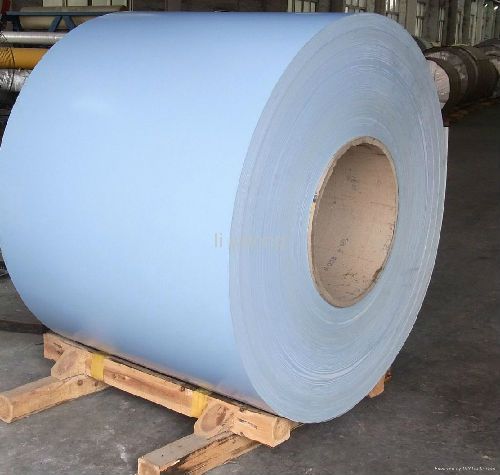
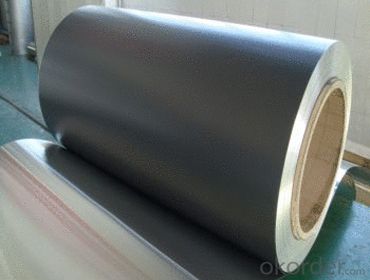
Aluminium Coil PPGL Specification:
Product Name | Aluminum Coil |
Alloy | A1100,A3003,A1050,A8011,A3105,A5005 etc |
Thickness | 0.022mm to 3.0 mm |
Width | Standard width:1240mm; 1200mm |
All width: 30mm - 1600mm | |
Diameter | out dia:1200mm |
Interior dia: 405mm,505mm | |
Weight | 2.5 T/coil,3.0 T/coil |
Coating | PE,PVDF,ACRYLIC |
Surface | Embossed, mill finish, coated; aluminum gutter coil |
Color | AS to all RAL color |
Gloss | 10-90%(EN ISO-2813:1994) |
Coating Thickness | PE: more than 18 micron |
PVDF: more than 25 micron | |
Coating Hardness (pencil resistance) | More than 2h |
Coating adhesion | 5J(EN ISO-2409:1994) |
Impact Resistance | No peeling or cracking(50 kg/cm,ASTMD-2794:1993) |
Flexibility (T-bend) | 2T |
MEK resistance | More than 100 |
FAQ of Aluminium Coil PPGL:
Material:1050/1060/1070/1100/2A16/2A06/2A12/2024/3003/3A21/4A01/5052/5005/5083/5A05/6061-T6/6063-T5/6082/7021/7075-T6/8011,etc
- Q: What specific considerations or precautions should be taken into account when using aluminum sheets in environments with high moisture levels?
- <p>When using aluminum sheets in damp or wet environments, it's important to consider the potential for corrosion. While aluminum is generally corrosion-resistant due to its protective oxide layer, it can still be susceptible to certain types of corrosion in the presence of moisture, especially if the environment is acidic or saline. It's crucial to use high-quality aluminum alloys that are designed for such conditions. Additionally, proper surface treatment such as anodizing or applying protective coatings can enhance resistance to corrosion. Regular inspections and maintenance are also recommended to check for signs of corrosion and to address any issues promptly.</p>
- Q: Can aluminum sheets be soldered?
- Yes, aluminum sheets can be soldered, but it requires some specific techniques and materials. Aluminum has a high thermal conductivity and a low melting point, which makes it challenging to solder using traditional methods. However, it can be soldered using specialized soldering techniques such as the use of flux and a soldering iron with a high temperature. Additionally, a specific type of solder called aluminum solder or aluminum flux-cored solder is required, as regular solder does not adhere well to aluminum surfaces. It is important to clean the aluminum surface thoroughly before soldering to ensure a strong bond. Overall, while soldering aluminum sheets can be more complex compared to other metals, it is possible with the right tools, materials, and techniques.
- Q: I got nauseous the other day and that day one thing I ate was hamburger baked for 1 hour on aluminum foil with tomatoes mixed in. Is it possible the upset stomach was caused by the tomatoes reacting with the foil?
- I got sick from fried chicken that had been laying in foil all afternoon. It had a foil taste. yuk. I have baked macaroni and cheese before and covered it with foil, then the foil would start disintegrating. Not sure why that happened, but ewww.
- Q: Are aluminum sheets suitable for roofing systems?
- Yes, aluminum sheets are suitable for roofing systems. Aluminum is a popular choice for roofing due to its durability, lightweight nature, and resistance to corrosion. It is also fire resistant and can withstand extreme weather conditions such as high winds and heavy rain. Aluminum roofing sheets are long-lasting and require minimal maintenance, making them a cost-effective option in the long run. Additionally, aluminum is a highly reflective material, which can help in reducing energy costs by keeping buildings cooler in hot climates. Overall, aluminum sheets are a reliable and efficient choice for roofing systems.
- Q: Can aluminum sheet be used for aerospace structural components?
- Yes, aluminum sheet can be used for aerospace structural components. Aluminum is a commonly used material in the aerospace industry due to its desirable properties such as high strength-to-weight ratio, corrosion resistance, and good formability. The use of aluminum sheet for structural components allows for the construction of lightweight aircraft, which is crucial for fuel efficiency and performance. Additionally, aluminum is readily available and cost-effective, making it a popular choice for aerospace applications. However, it is important to note that the specific grade and thickness of the aluminum sheet used will depend on the particular requirements and specifications of the aerospace structural component.
- Q: What are the different methods of punching aluminum sheets?
- There are several different methods used for punching aluminum sheets, each with its own advantages and limitations. Here are some of the most common methods: 1. Manual Punching: This is the most basic method, where a handheld punch tool is used to manually punch holes or shapes into the aluminum sheet. It is suitable for small-scale projects and simple designs, but it can be time-consuming and less precise compared to other methods. 2. Mechanical Punching: Mechanical punching machines utilize a mechanical press with a punch and die set to punch holes or shapes into the aluminum sheet. These machines are capable of higher production rates and offer better accuracy and repeatability. This method is suitable for medium to large-scale projects. 3. CNC Punching: Computer Numerical Control (CNC) punching machines use computer programming to control the movement of the punch and die set. This method allows for the punching of complex shapes, patterns, and multiple holes in a single operation. CNC punching offers high precision, efficiency, and versatility, making it popular in industrial settings. 4. Laser Punching: Laser punching combines laser cutting and punching technologies. A high-powered laser beam is used to heat and soften the aluminum sheet, followed by a mechanical punch that creates the desired hole or shape. Laser punching offers high precision, speed, and the ability to work with various materials and thicknesses. It is commonly used in the automotive and aerospace industries. 5. Waterjet Punching: Waterjet punching involves using a high-pressure stream of water mixed with abrasive materials to cut through the aluminum sheet. This method is ideal for cutting complex shapes and thick materials. It offers high precision, minimal material distortion, and the ability to work with a wide range of materials. The choice of punching method depends on factors such as the complexity of the design, required precision, production volume, and budget. It is important to consider these factors and consult with professionals to determine the most suitable punching method for a specific aluminum sheet application.
- Q: Can 101 aluminum sheets be purchased in small quantities or only in bulk?
- Both small quantities and bulk purchases of aluminum sheets are typically available. The availability may vary depending on the supplier or retailer, but many offer aluminum sheets in a range of sizes and quantities to meet the diverse needs of customers. Whether you need a few sheets for a small project or a larger quantity for industrial purposes, it is beneficial to explore different suppliers to find the option that aligns with your requirements.
- Q: What types of bonds can aluminum form: Covalent, Ionic and/or Metallic?Could you post the source, I've been looking for a while now :/
- Well, any metal can have metallic bonds. Aluminum is a metal and is able to alloy with other metals to modify its properties. The criteria for covalent versus ionic are: (see link 1) If the electronegativities are equal (i.e. if the electronegativity difference is 0), the bond is non-polar covalent. If the difference in electronegativities between the two atoms is greater than 0, but less than 2.0, the bond is polar covalent. If the difference in electronegativities between the two atoms is 2.0, or greater, the bond is ionic. All you need to do is determine the difference in electronegativity to see if the bond is polar covalent or ionic for the compounds of aluminum. The official line is that if a metal and a nonmetal react then the bond is ionic. But, it is not quite that simple. We finally have to look at the difference in electronegativity between the element that make up the compound. Examples: Aluminum oxide Al2O3, aluminum chloride AlCl3 (actually this is Al2Cl6), aluminum fluoride AlF3, aluminum carbide Al4C3. Electronegativity (Pauling Scale): 1.61 for Al Electronegativity (Pauling Scale): 3.44 for O Difference = 1.83 Bond is polar covalent Electronegativity (Pauling Scale): 1.61 for Al Electronegativity (Pauling Scale): 3.16 for Cl Difference = 1.55 Bond is polar covalent Electronegativity (Pauling Scale): 1.61 for Al Electronegativity (Pauling Scale): 3.98 for F Difference = 2.37 Bond is ionic Electronegativity (Pauling Scale): 1.61 for Al Electronegativity (Pauling Scale): 2.55 for C Difference = 0.94 Bond is polar covalent This type of analysis can be done for many other actual compounds of aluminum. Try some yourself. Hope this is helpful to you. JIL HIR
- Q: What are the different surface patterns or textures available for aluminum sheets?
- There are several different surface patterns and textures available for aluminum sheets, each designed to serve specific purposes and provide unique aesthetic appeal. Some of the most common surface patterns or textures for aluminum sheets include: 1. Smooth: Smooth aluminum sheets have a flat and polished surface without any visible patterns or textures. This type of finish is often used for applications where a clean and sleek appearance is desired, such as architectural elements or interior design. 2. Diamond Plate: Diamond plate aluminum sheets feature a raised diamond pattern on the surface, which provides excellent traction and slip resistance. This texture is commonly used for flooring, stairs, ramps, and industrial applications where grip and durability are essential. 3. Brushed: Brushed aluminum sheets have a consistent linear pattern created by brushing the surface with fine abrasive pads. This finish gives a satin-like appearance, making it popular for decorative purposes like signs, furniture, appliances, and automotive trim. 4. Stucco: Stucco textured aluminum sheets have a raised pattern resembling a stucco wall finish. This texture is achieved by embossing the sheet with a stucco roller, creating a rough and durable surface. Stucco patterned sheets are commonly used for exterior cladding, roofing, and decorative applications. 5. Hammered: Hammered aluminum sheets have a unique texture that resembles the surface of hammered metal. This finish is achieved by imprinting the sheet with a pattern of small indentations using a hammer or similar tool. Hammered sheets are often used for decorative purposes, such as backsplashes, countertops, and art installations. 6. Perforated: Perforated aluminum sheets have a pattern of small holes punched into the surface, allowing for airflow, light transmission, and sound absorption. This texture is commonly used for architectural elements, screens, filters, and ventilation systems. These are just a few examples of the surface patterns and textures available for aluminum sheets. Each texture serves a specific purpose and provides distinct visual appeal, allowing for a wide range of applications in various industries.
- Q: Can aluminum sheets be anodized for added durability?
- Yes, aluminum sheets can be anodized for added durability. Anodizing is an electrochemical process that forms a protective oxide layer on the surface of aluminum, increasing its corrosion resistance, hardness, and overall durability.
Send your message to us
CC Route Aluminum Sheet For Building Industries
- Loading Port:
- Shanghai
- Payment Terms:
- TT OR LC
- Min Order Qty:
- 1 m.t.
- Supply Capability:
- 2000 m.t./month
OKorder Service Pledge
OKorder Financial Service
Similar products
Hot products
Hot Searches
Related keywords
